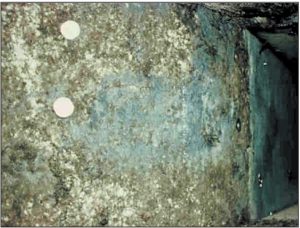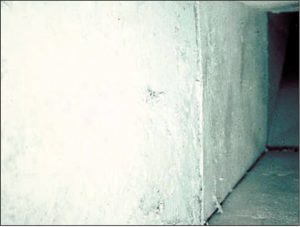Mold Gets Ten Years to Life
Product: Foster® 40-20® Fungicidal Protective Coating.
Application: Fibrous glass duct liner in HVAC system
Facility: Maximum Security Prison
Location: Midwestern United States
Introduction

Prior to application of Foster® 40-20® coating, fungal wipe samples on the fibrous glass duct liner showed average fungal levels of 45,000 colony forming units per square centimeter (cfu/cm2).
In 1982, a new maximum security prison was built in the midwestern United States. The architectural firm who designed the facility won awards for innovative design techniques aimed at reducing energy consumption. Unfortunately, one of the side effects of the reduced energy consumption was an environment that was conducive to mold growth on the interior surfaces of the HVAC duct work.
The indoor air quality in the prison became a source of continual complaints. As a result, the warden of the prison hired Paul Ellringer, PE, and a Certified Industrial Hygienist to investigate the situation, and develop a solution to clear the air. Mr. Ellringer’s investigation uncovered elevated mold spore counts in a variety of areas. Further examination determined that the mold was growing on the fibrous glass duct liner inside the buildings ventilation system.
Initial cleaning methods fail
The duct system was cleaned of all visible mold and fumigated with chlorine dioxide to clean the affected system. Less than one year later, a new inspection and testing of the duct work revealed that the fungi had returned and had reached a level as serious as before the initial treatment had taken place.
New approach using Foster® 40-20®
In his research for a solution to this problem, Mr. Ellringer discovered a water-based, acrylic coating formulated for long-term resistance to mold growth – Foster® 40-20® coating. At his direction, the surface of the duct liner was cleaned by HEPA vacuum cleaner and Foster® 40-20® coating was applied directly to the liner in designated areas. This solution provided a flexible, tough film that retarded the release of fibers and erosion of the insulation.
Ten Years Later

After ten years the fungal wipe samples from the coating surface areas showed an average of 7 cfu/cm2 -meaning nominal growth!
To ensure a continually high level of indoor air quality, the duct work was inspected, and the coated surface tested for fungi after one year, three years, five years, and then again ten years after the initial coating application. Testing and observations taken during
each subsequent inspection where Foster® 40-20® had been applied revealed that there was NO visible mold growth on the surface, and surface wipe testing also revealed NO mold growth of any sort. In areas where the coating had not been applied, testing and
observations revealed continued significant fungal growth. The warden of the prison was, and continues to be, extremely satisfied with the results of the Foster® 40-20® coating solution!
